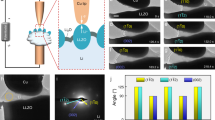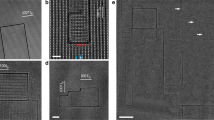Abstract
Solid electrolytes hold great promise for enabling the use of Li metal anodes. The main problem is that during cycling, Li can infiltrate along grain boundaries and cause short circuits, resulting in potentially catastrophic battery failure. At present, this phenomenon is not well understood. Here, through electron microscopy measurements on a representative system, Li7La3Zr2O12, we discover that Li infiltration in solid oxide electrolytes is strongly associated with local electronic band structure. About half of the Li7La3Zr2O12 grain boundaries were found to have a reduced bandgap, around 1–3 eV, making them potential channels for leakage current. Instead of combining with electrons at the cathode, Li+ ions are hence prematurely reduced by electrons at grain boundaries, forming local Li filaments. The eventual interconnection of these filaments results in a short circuit. Our discovery reveals that the grain-boundary electronic conductivity must be a primary concern for optimization in future solid-state battery design.
This is a preview of subscription content, access via your institution
Access options
Access Nature and 54 other Nature Portfolio journals
Get Nature+, our best-value online-access subscription
$29.99 / 30 days
cancel any time
Subscribe to this journal
Receive 12 print issues and online access
$259.00 per year
only $21.58 per issue
Buy this article
- Purchase on Springer Link
- Instant access to full article PDF
Prices may be subject to local taxes which are calculated during checkout





Similar content being viewed by others
Data availability
The data that support the findings of this study are available from the corresponding authors upon reasonable request.
References
Lin, D., Liu, Y. & Cui, Y. Reviving the lithium metal anode for high-energy batteries. Nat. Nanotechnol. 12, 194–206 (2017).
Xu, W. et al. Lithium metal anodes for rechargeable batteries. Energy Environ. Sci. 7, 513–537 (2014).
Albertus, P., Babinec, S., Litzelman, S. & Newman, A. Status and challenges in enabling the lithium metal electrode for high-energy and low-cost rechargeable batteries. Nat. Energy 3, 16–21 (2018).
Han, F. et al. High electronic conductivity as the origin of lithium dendrite formation within solid electrolytes. Nat. Energy 4, 187–196 (2019).
Porz, L. et al. Mechanism of lithium metal penetration through inorganic solid electrolytes. Adv. Energy Mater. 7, 1701003 (2017).
Ren, Y., Shen, Y., Lin, Y. & Nan, C. W. Direct observation of lithium dendrites inside garnet-type lithium-ion solid electrolyte. Electrochem. Commun. 57, 27–30 (2015).
Aguesse, F. et al. Investigating the dendritic growth during full cell cycling of garnet electrolyte in direct contact with Li metal. ACS Appl. Mater. Interfaces 9, 3808–3816 (2017).
Cheng, E. J., Sharafi, A. & Sakamoto, J. Intergranular Li metal propagation through polycrystalline Li6.25Al0.25La3Zr2O12 ceramic electrolyte. Electrochim. Acta 223, 85–91 (2017).
Sharafi, A., Meyer, H. M., Nanda, J., Wolfenstine, J. & Sakamoto, J. Characterizing the Li–Li7La3Zr2O12 interface stability and kinetics as a function of temperature and current density. J. Power Sources 302, 135–139 (2016).
Ma, C. et al. Interfacial stability of Li metal–solid electrolyte elucidated via in situ electron microscopy. Nano Lett. 16, 7030–7036 (2016).
Cheng, L. et al. The origin of high electrolyte–electrode interfacial resistances in lithium cells containing garnet type solid electrolytes. Phys. Chem. Chem. Phys. 16, 18294–18300 (2014).
Zhu, Y., He, X. & Mo, Y. First principles study on electrochemical and chemical stability of solid electrolyte–electrode interfaces in all-solid-state Li-ion batteries. J. Mater. Chem. A 4, 3253–3266 (2016).
Hofstetter, K., Samson, A. J., Narayanan, S. & Thangadurai, V. Present understanding of the stability of Li-stuffed garnets with moisture, carbon dioxide, and metallic lithium. J. Power Sources 390, 297–312 (2018).
Li, Y. et al. Garnet electrolyte with an ultralow interfacial resistance for Li-metal batteries. J. Am. Chem. Soc. 140, 6448–6455 (2018).
Yu, S. et al. Elastic properties of the solid electrolyte Li7La3Zr2O12 (LLZO). Chem. Mater. 28, 197–206 (2016).
Ni, J. E., Case, E. D., Sakamoto, J. S., Rangasamy, E. & Wolfenstine, J. B. Room temperature elastic moduli and Vickers hardness of hot-pressed LLZO cubic garnet. J. Mater. Sci. 47, 7978–7985 (2012).
Shen, F., Dixit, M. B., Xiao, X. & Hatzell, K. B. Effect of pore connectivity on Li dendrite propagation within LLZO electrolytes observed with synchrotron X-ray tomography. ACS Energy Lett. 3, 1056–1061 (2018).
Suzuki, Y. et al. Transparent cubic garnet-type solid electrolyte of Al2O3-doped Li7La3Zr2O12. Solid State Ion. 278, 172–176 (2015).
Sudo, R. et al. Interface behavior between garnet-type lithium-conducting solid electrolyte and lithium metal. Solid State Ion. 262, 151–154 (2014).
Duan, H., Zheng, H., Zhou, Y., Xu, B. & Liu, H. Stability of garnet-type Li ion conductors: an overview. Solid State Ion. 318, 45–53 (2018).
Yang, C. et al. Continuous plating/stripping behavior of solid-state lithium metal anode in a 3D ion-conductive framework. Proc. Natl Acad. Sci. USA 115, 3770–3775 (2018).
Wu, B. et al. The role of the solid electrolyte interphase layer in preventing Li dendrite growth in solid-state batteries. Energy Environ. Sci. 11, 1803–1810 (2018).
Fu, K. K. et al. Toward garnet electrolyte–based Li metal batteries: an ultrathin, highly effective, artificial solid-state electrolyte/metallic Li interface. Sci. Adv. 3, e1601659 (2017).
Sharafi, A. et al. Surface chemistry mechanism of ultra-low interfacial resistance in the solid-state electrolyte Li7La3Zr2O12. Chem. Mater. 29, 7961–7968 (2017).
Tsai, C. L. et al. Li7La3Zr2O12 interface modification for Li dendrite prevention. ACS Appl. Mater. Interfaces 8, 10617–10626 (2016).
Wu, B. et al. The role of the solid electrolyte interphase layer in preventing Li dendrite growth in solid-state batteries. Energy Environ. Sci. 11, 1803–1810 (2018).
Tian, H. K., Liu, Z., Ji, Y., Chen, L. Q. & Qi, Y. Interfacial electronic properties dictate Li dendrite growth in solid electrolytes. Chem. Mater. 31, 7351–7359 (2019).
Yu, S. & Siegel, D. J. Grain boundary contributions to Li-ion transport in the solid electrolyte Li7La3Zr2O12 (LLZO). Chem. Mater. 29, 9639–9647 (2017).
Hachtel, J. A., Lupini, A. R. & Idrobo, J. C. Exploring the capabilities of monochromated electron energy loss spectroscopy in the infrared regime. Sci. Rep. 8, 5637 (2018).
Zhan, W. et al. Nanoscale mapping of optical band gaps using monochromated electron energy loss spectroscopy. Nanotechnology 28, 105703 (2017).
Tizei, L. H. G. et al. Exciton mapping at subwavelength scales in two-dimensional materials. Phys. Rev. Lett. 114, 107601 (2015).
Thompson, T. et al. Electrochemical window of the Li-ion solid electrolyte Li7La3Zr2O12. ACS Energy Lett. 2, 462–468 (2017).
Bean, J. J. et al. Atomic structure and electronic properties of MgO grain boundaries in tunnelling magnetoresistive devices. Sci. Rep. 7, 45594 (2017).
Chisholm, M. F. et al. Electronic structure of a grain-boundary model in SrTiO3. Phys. Rev. B 60, 2416–2424 (1999).
Guhl, H. et al. Structural and electronic properties of Σ7 grain boundaries in α-Al2O3. Acta Mater. 99, 16–28 (2015).
Rangasamy, E., Wolfenstine, J. & Sakamoto, J. The role of Al and Li concentration on the formation of cubic garnet solid electrolyte of nominal composition Li7La3Zr2O12. Solid State Ion. 206, 28–32 (2012).
Knauth, P. Inorganic solid Li ion conductors: an overview. Solid State Ion. 180, 911–916 (2009).
Ma, C. et al. Atomic-scale origin of the large grain-boundary resistance in perovskite Li-ion-conducting solid electrolytes. Energy Environ. Sci. 7, 1638–1642 (2014).
Lazar, S., Botton, G. A., Wu, M.-Y., Tichelaar, F. D. & Zandbergen, H. W. Materials science applications of HREELS in near edge structure analysis and low-energy loss spectroscopy. Ultramicroscopy 96, 535–546 (2003).
Park, J. & Yang, M. Determination of complex dielectric functions at HfO2/Si interface by using STEM-VEELS. Micron 40, 365–369 (2009).
Acknowledgements
This work was initiated as part of a project supported by the US Department of Energy (DOE), Office of Science, Basic Energy Sciences, Materials Sciences and Engineering Division. Technique developments and M.C.’s efforts on analysis and manuscript preparation were supported by DOE Basic Energy Sciences early career award no. ERKCZ55. Microscopy was conducted at Oak Ridge National Laboratory’s Center for Nanophase Materials Sciences, which is a DOE Office of Science User Facility. A.S. and J.S. acknowledge support from the DOE Advanced Battery Material Research programme grant no. DE-EE00006821. Y.C. acknowledges computing resources made available through the VirtuES project, funded by Laboratory Directed Research and Development programme and Compute and Data Environment for Science (CADES). C.M. acknowledges support from the National Key R&D Program of China (2018YFA0209600, 2017YFA0208300), the National Natural Science Foundation of China (51802302) and the Fundamental Research Funds for the Central Universities (WK2060190085, WK3430000006). M.C. thanks R. Erni at ETH Zurich for the valuable discussions on valence-EELS analysis. Part of the research was conducted using instrumentation within ORNL’s Materials Characterization Core provided by UT-Batelle under contract no. DE-AC05-00OR22725 with the DOE.
Author information
Authors and Affiliations
Contributions
M.C. conceived the study. X.L. performed the TEM, EELS, SEM and EDX. R.G.-M., A.S. and J.S. performed the LLZO synthesis, electrochemical measurements and electron backscatter diffraction. A.R.L., J.C.I. and M.C. performed the valence-EELS experiments and carried out the related analysis. C.W. and F.H. performed SEM characterizations. Y.C. performed density functional theory calculations. M.C., C.W., C.M., Y.C. and J.S. interpreted the results. C.M. and X.L. wrote the manuscript. All authors contributed to the discussion of the results and the manuscript editing.
Corresponding authors
Ethics declarations
Competing interests
The authors declare no competing interests.
Additional information
Peer review information Nature Materials thanks the anonymous reviewers for their contribution to the peer review of this work.
Publisher’s note Springer Nature remains neutral with regard to jurisdictional claims in published maps and institutional affiliations.
Supplementary information
Supplementary Information
Supplementary Figs. 1–9.
Rights and permissions
About this article
Cite this article
Liu, X., Garcia-Mendez, R., Lupini, A.R. et al. Local electronic structure variation resulting in Li ‘filament’ formation within solid electrolytes. Nat. Mater. 20, 1485–1490 (2021). https://doi.org/10.1038/s41563-021-01019-x
Received:
Accepted:
Published:
Issue Date:
DOI: https://doi.org/10.1038/s41563-021-01019-x
This article is cited by
-
Principal component analysis enables the design of deep learning potential precisely capturing LLZO phase transitions
npj Computational Materials (2024)
-
Lithium anode interlayer design for all-solid-state lithium-metal batteries
Nature Energy (2024)
-
Li plating–stripping behaviors in Li+/Na+ mixed iodide electrolytes with small amount of BH4−
Journal of Solid State Electrochemistry (2024)
-
From Liquid to Solid-State Lithium Metal Batteries: Fundamental Issues and Recent Developments
Nano-Micro Letters (2024)
-
A lithium–tin fluoride anode enabled by ionic/electronic conductive paths for garnet-based solid-state lithium metal batteries
Rare Metals (2024)



